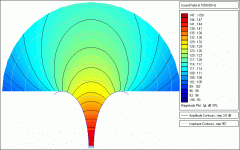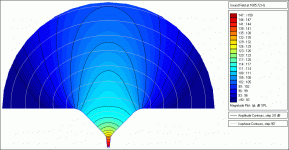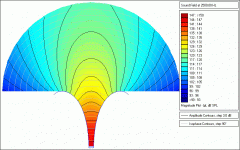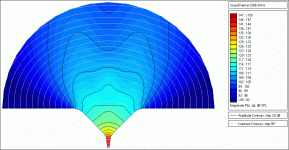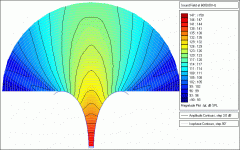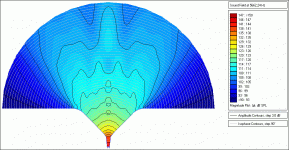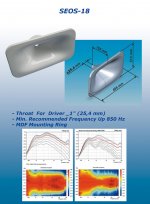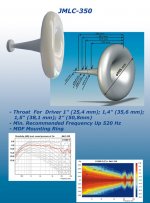Lynn,To the dismay of some readers, I am not interested in constant directivity. There. I said it. Really, I mean it.
So where did this magic 90-degree number come from? I have no idea, except as a residue of sound-reinforcement practice. It's much wider than the high-quality listening area at the back of the room, and yet, it's not wide enough to cover the first group of reflections that arrive at the listener. Most of the early reflections are well outside the constant-directivity cone ... while the woofer is not particularly directional in the sub-500 Hz region.
Non-constant-directivity horns like the LeCleac'h have a very soft edge to the forward pattern. This means when you walk around the speaker, you can still hear the horn, even when you're far off-axis.
Personally, never found the back of a room to be "the high-quality listening area"
The "magic" 90-degree horns date back to monophonic movie theater reproduction, from behind the screen a 90 degree horn can cover the front seats without to much reflection off sidewalls.
90 degrees happens to match the -6dB beam width of typical 15" front or horn loaded woofers at around 500 Hz, a popular crossover frequency for 15' + (big) HF horn, matching horizontal directivity and avoiding upper cone breakup hash.
It takes around a two foot diameter constant directivity horn to "turn off" (be -6 dB) at 500 Hz, smaller mouths will of course have a "soft edge" at a higher frequency.
What is the -6 dB beamwidth of the horn you are using in the "Beyond the Ariel" prototype at 500, 2000, 4000, 10,000 Hz?
Art
Last edited:
The spectra of the reflection from the opposite walls is of considerable interest. Arguably, that's what audiophiles are adjusting when they rotate their speakers ... the spectral contribution from the rear wall versus the opposite walls. If a loudspeaker has sharp edges to the directivity pattern, this rotation would have to be done carefully.
Part of the discussion about bass horns might be more about changes in directivity versus frequency than the distortion and headroom of the bass horns. Direct-radiators are nearly omnidirectional by 300 Hz, a big change from what the MF/HF horn is doing at 1 kHz.
There is no evidence to suggest that we can perceive the spectral content of individual reflections. Besides, the content we hear will be determined by the delay of the reflected sound as well. Flat on axis plus flat reflected doesn't always sum to flat total, not in measurements and not perceptually either.
While I'm personally chasing after midbass horns, there is a design school that allows matching of directivity of the woofer to the horn, resulting in smooth transition on and off-axis.
I really like the Keele EV HR9040 quasi-radial 500 to 3000 with EV 1012. They are 90 degree horns done right. Way better to me then the tractrix beamers or the "OS" waveguide (the ultra fake king) with any drivers (Tad, Radian, Altec ect). Of course they are 40" wide, but who cares if you want the best in realism? We hall have our own perspectives.
There is no evidence to suggest that we can perceive the spectral content of individual reflections. Besides, the content we hear will be determined by the delay of the reflected sound as well. Flat on axis plus flat reflected doesn't always sum to flat total, not in measurements and not perceptually either.
I agree. The spectra of the (combined) reflections affects the spatial impression, and has less effect on perception of tonality. The first-arrival FFT does not tell the whole story, and neither does the room summation of 1/3 octave RTAs.
Comment of the BEM simulations: there's no simulation of a diaphragm or phase plug assembly, with a flat plane wave entering the horn. In other words, both diaphragms and phase plugs are assumed to be perfect. In the real world, phase plugs depart from ideal at high frequencies, further disrupting the wavefront entering the horn.
The reason for a supertweeter should be obvious; aside from trouble from the phase-plug and diaphragm breakup, narrowing directivity (and spatial roughness from the CD waveguide) tells us that another HF system is a good idea.
Last edited:
Part of the discussion about bass horns might be more about changes in directivity versus frequency than the distortion and headroom of the bass horns. Direct-radiators are nearly omnidirectional by 300 Hz, a big change from what the MF/HF horn is doing at 1 kHz.
I suspect that differences in directivity influence room modes in different ways. I also suspect that since the horn has a great influence on the acoustic load of the driver, which is much higher and less varied, the horn driver output is less influenced by variation in acoustic loads outside the influenced by room modes or other boundaries.
There was a statement-- in one of the Keele papers, I believe--that struck home. He said something to the effect that if a horn loaded driver is 50% efficient, it can't vary by more than 3db higher or it would be over 100% efficient, or something of that nature. Puts things in perspective.
I think Linkwitz explains the effects of reflection spectrum quite reasonably, but I wonder whether use of dipoles is the solution mainly because the room does not have uniform absorption, and waves pass through each other while we listen to not so perfect cancellation effects. This in nature is not much different from diffraction we try to avoid.I notice that the Kates paper is based on listening in an anechoic chamber ... which is not a realistic assumption for 99.9% of listeners. In the following paragraph, the presence of room reflections are used as an argument for narrower directivity, neatly side-stepping any discussion of real loudspeakers made with combinations of direct radiators and horn/waveguides.
I think Linkwitz is on more solid ground, with loudspeakers that are uniform in directivity over the working bandwidth, thanks to dipole radiation.
I agree. The spectra of the (combined) reflections affects the spatial impression, and has less effect on perception of tonality. The first-arrival FFT does not tell the whole story, and neither does the room summation of 1/3 octave RTAs.
Comment of the BEM simulations: there's no simulation of a diaphragm or phase plug assembly, with a flat plane wave entering the horn. In other words, both diaphragms and phase plugs are assumed to be perfect. In the real world, phase plugs depart from ideal at high frequencies, further disrupting the wavefront entering the horn.
The reason for a supertweeter should be obvious; aside from trouble from the phase-plug and diaphragm breakup, narrowing directivity (and spatial roughness from the CD waveguide) tells us that another HF system is a good idea.
The total transition from the diaphragm through the throat seems to be a critical factor. The simulation is only valid for where the simulated diaphragm is.
I think I may have read this before, the study of ILD and ITD seem quite convincing. I think it might have been Pano that posted some level and delay shifting files for people to listen and respond on, I may have been one of the very few that posed any response. But it was interesting to see how level and delay each effected perceived imaging.Probably came from the paper of of Kates, "Optimum Loudspeaker Direction Patterns"
http://www.google.com/url?sa=t&rct=j&q=&esrc=s&frm=1&source=web&cd=4&cad=rja&ved=0CD4QFjAD&url=http%3A%2F%2Fdecoy.iki.fi%2Fdsound%2Fambisonic%2Fmotherlode%2Fsource%2FOptimum%2520loudspeaker%2520directional%2520patterns_Kates_1980.pdf&ei=CeiPUsK4OrGA2QXJyIGQAQ&usg=AFQjCNGd5Vv2KSkoqOo7F2t_5uq0tkUZmQ
Since I believe that one should solve the problem at the source of it, I acknowledge the need to have reasonable control on directivity and the smoothness of response transition going off access. As we can see, listening distance and pattern needs to be considered hand in hand, so one needs identify the expected optimum listening location relative to the speakers as this will change the ILD and ITD change ratio as we move from side to side. It seems to me the flatter the listening triangle, the more directivity you will need.
I think I have around 35 or so different mid/treble horns here (AH425 nope) the main reason being they work different with different drivers, different rooms, listening positions, crossovers, rossover points, bass systems, treble systems and mood among other things. Surely Lyn Olson's horn may sound great to him. I wonder though how many tractrix or 90 degree horns you've actually lived with? How many horn sysyems have you actually completed?
My point is integration will be the key to get them to really spook you into believing the sound in your room is real. Based on having similar horns to yours I can't see that happening 100 % without mating it with a long directional hypex or expo bass horn, probably with an 8 or 10 inch driver. With a good 90 degree CD style horn you can get away with a shorter horn with a 15, or possibly even a dreaded reflex box. I know many people that tried to integrate a directional horn like yours with short altec horn reflex and went back to radial because it never sounded ad good overall, As far as the ribbon sitting there with it's wide dispersion several inches away from the compression driver - some people actually like that, that's why JBL sold so many 2405's.
My point is integration will be the key to get them to really spook you into believing the sound in your room is real. Based on having similar horns to yours I can't see that happening 100 % without mating it with a long directional hypex or expo bass horn, probably with an 8 or 10 inch driver. With a good 90 degree CD style horn you can get away with a shorter horn with a 15, or possibly even a dreaded reflex box. I know many people that tried to integrate a directional horn like yours with short altec horn reflex and went back to radial because it never sounded ad good overall, As far as the ribbon sitting there with it's wide dispersion several inches away from the compression driver - some people actually like that, that's why JBL sold so many 2405's.
I notice that the Kates paper is based on listening in an anechoic chamber ... which is not a realistic assumption for 99.9% of listeners. In the following paragraph, the presence of room reflections are used as an argument for narrower directivity, neatly side-stepping any discussion of real loudspeakers made with combinations of direct radiators and horn/waveguides.
I think Linkwitz is on more solid ground, with loudspeakers that are uniform in directivity over the working bandwidth, thanks to dipole radiation.
Lynne, How do you see the Orion up against a good horn mid/tweeter, and bass reflex double woofer, possibly with a RAAL super tweeter. Is there a magic where the horn brings more reality or something else to the reproduction. This is assuming sufficient watts available from valves preferably DHT.
Each time I review the Beyond Ariel it seems mostly very right in making the well considered compromise judgments of all the important properties. We know it is all a balance. I have reviewed other alternatives and they of course run a different set of compromises.
But is it direct drivers done to the limit or is a good modern horn still the winner like what the Beyond Arial will be. Summa is well supported as a superlative speaker, and Beyond Ariel seems its going the same way esp with the Be diaphragm
I have avoided the technical arguments here intentionally. I do not care about constant directivity per se and I do enjoy listening off axis when it suits me.
Thanks
I think I have around 35 or so different mid/treble horns here (AH425 nope) the main reason being they work different with different drivers, different rooms, listening positions, crossovers, rossover points, bass systems, treble systems and mood among other things. Surely Lyn Olson's horn may sound great to him. I wonder though how many tractrix or 90 degree horns you've actually lived with? How many horn sysyems have you actually completed?
My point is integration will be the key to get them to really spook you into believing the sound in your room is real. Based on having similar horns to yours I can't see that happening 100 % without mating it with a long directional hypex or expo bass horn, probably with an 8 or 10 inch driver. With a good 90 degree CD style horn you can get away with a shorter horn with a 15, or possibly even a dreaded reflex box. I know many people that tried to integrate a directional horn like yours with short altec horn reflex and went back to radial because it never sounded ad good overall, As far as the ribbon sitting there with it's wide dispersion several inches away from the compression driver - some people actually like that, that's why JBL sold so many 2405's.
Thanks for this helpful post. This represents a mature statistical reality. We could and may be doing these variations and wondering if we will ever get to expectations. With this mix of interested views and debate I hope so.
Last edited:
…
My point is integration will be the key to get them to really spook you into believing the sound in your room is real.
…
AFAIK, this is unattainable. The best we can strive for is as high degree of realism as possible. However no reproduction system will ever fool an experienced listener, brought into a room blindfolded, to think/feel that one is listening to live music.
If I'm wrong here, if anyone managed to do it, I'd love to hear it.
AFAIK, this is unattainable. The best we can strive for is as high degree of realism as possible. However no reproduction system will ever fool an experienced listener, brought into a room blindfolded, to think/feel that one is listening to live music.
If I'm wrong here, if anyone managed to do it, I'd love to hear it.
Once I went to visit an artist, while standing outside the gates to the yard, I hear someone playing piano and thought, 'my, this is really good, it can't be his wife or daughter could it?'. Well, when I walked into the living room, it was the pair of speakers we had worked in together playing.
I think you can be fooled under certain conditions. If you start getting into tests, then the situation is different because of any combination of reasons. First that comes to mind is that if the recording has it's own room ambience, then it does get mixed and confusing with the listening room. You also know that the energy reflection in the room can never render a realistic orchestral performance. These are just examples of things that have no relation with system performance.
AFAIK, this is unattainable. The best we can strive for is as high degree of realism as possible. However no reproduction system will ever fool an experienced listener, brought into a room blindfolded, to think/feel that one is listening to live music.
If I'm wrong here, if anyone managed to do it, I'd love to hear it.
One huge problem that NO loudspeaker can address is the limitations created by the 2-channel stereo format itself. It simply defies nature to present any individual sound source by using multiple sources (loudspeakers) located elsewhere.
As long as we are using traditional stereo, convincing realism for more than fleeting moments on selected recordings from a single listening position is the best that can be hoped for.
A little time spent testing stereo imaging with pink noise or clicks reveal all, and can temporarily ruin one's ability to get immersed in the stereo. Only recordings that are highly diffuse "work" for me anymore on 2 channel playback.
-- Mark
Once I went to visit an artist, while standing outside the gates to the yard, I hear someone playing piano and thought, 'my, this is really good, it can't be his wife or daughter could it?'. Well, when I walked into the living room, it was the pair of speakers we had worked in together playing.
I doubt if a pianist, entering the room blindfolded, would think it is a real piano.
There is difference between listening from outside the room and inside the room.
...
You also know that the energy reflection in the room can never render a realistic orchestral performance.
…
This demonstrates but one aspect of why I said it. Also, it applies to chamber music as well.
Also, I haven't heard a system that reproduces even a single acoustic instrument in a way that it is indistinguishable from a real, live, instrument.
I doubt if there is one. If there is one, I'd love to hear it.
- Home
- Loudspeakers
- Multi-Way
- Beyond the Ariel
